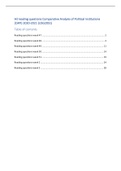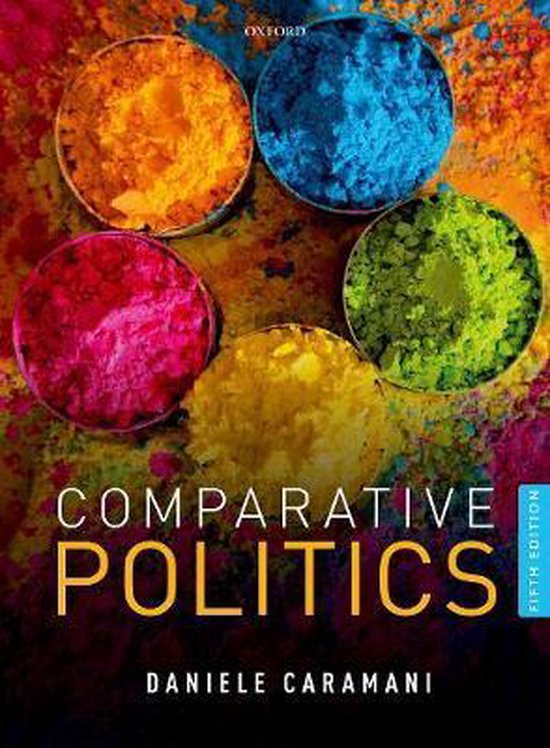All reading questions Comparative Analysis of Political Institutions
(CAPI) 2020-2021 (USG2051)
Table of contents
Reading questions week 47 ...................................................................................................... 2
Reading questions week 48 ...................................................................................................... 4
Reading questions week 49 .................................................................................................... 11
Reading questions week 50 .................................................................................................... 14
Reading questions week 51 .................................................................................................... 19
Reading questions week 2 ...................................................................................................... 24
Reading questions week 3 ...................................................................................................... 28
,Reading questions week 47
1. As a starting point of this course, write down:
a. How would you describe the field of comparative politics in your own terms.
Potential answers might include the study and empirical analysis of internal political
structures, actors, and processes, in order to describe, explain and predict their variety
(similarities and differences) across political systems (and over time) – be they national
political systems, regional, municipal, or even supra- national. As Caramani states, ‘All the
dimensions of the political system can be compared, so all is potentially comparative
politics.’
b. Why do people study comparative politics, i.e. what is the relevance, in your view?
A possible answer might be, explaining questions such as: why does country X have a higher
economic growth? Why does country Y have such a huge welfare state? Why does country Z
have high political trust?
2. In the introductory chapter, Caramani discusses David Easton’s concept of political
system.
a. What does this concept refer to?
A set of structures (institutions and agencies) whose decision-making function is to reach the
collective and authoritative allocation of values (output, i.e. public policies) receiving support
as well as demands (inputs) from the domestic as well as the international environment
which it shapes through outputs in the feedback loop (see pp. 8-9)
b. Does it help you to get a better understanding of the political context you know best?
If so, how?
The aim of this question is to foster discussion rather than testing the knowledge of
students. A possible answer might be: more systematic insight in the political process (in NL
or other country), relationship between democratic input and output.
3. In the introductory chapter, Caramani states that comparative politics is one of the
three main subfields of political science, alongside international relations and political
theory. He thereby considers public administration as a part of comparative politics. In some
countries, by contrast, such as the Netherlands, the United States and South Korea, political
science and public administration are rather seen as separate disciplines.
a. How would you define these disciplines? And how do you think they are related to
one another?
Political science studies the conflict or competition for power as well as the ways in which
public and authoritative decisions are made.
Public Administration focuses on the processes by which decisions and policies are made
within administrative systems and particularly within the state, accordingly, it also includes
the practical side of government.
From this perspective, political science is a more comprehensive study, i.e. of politics as a
whole. Importantly, however, both fields of study cannot ignore each other. After all, public
policies are decided by the dynamics of political forces, whilst the latter are shaped by public
policies (which, in turn, are implemented by public administrators).
2
,b. How can this concept help to get a better understanding of the relationship between
political science and public administration?
Easton’s system depicts the effects political factors and processes (the field of political
scientists) on public policies (the field of researchers in public administration) through the
political system (covering most of what we will discuss during this course).
4. The second chapter discusses the ‘institutional turn’ in the social sciences.
a. How would you define the term ‘institution’ within the field of political science?
An institution, in political science, can be defined as “a set of formal rules (including
constitutions), informal norms, or shared understandings that constrain and prescribe
social/political actors’ interactions with one another.”
Perhaps also indicate that there several intellectual streams within the discipline, including
rational choice institutionalism, historical institutionalism, normative institutionalism, and
sociological institutionalism
b. What does this institutional turn refer to?
The ‘institutional turn’ implies a shift away from a focus on structural variables for explaining
why some societies are more successful than others in providing human well-being, towards
an increased relevance of comparative politics, as the creation, design, and operations of
political institutions are among the central objects of study.
c. How is the institutional turn related to the idea that comparative politics has a
potential for serving more general goals, like increased social justice and improved human
well-being?
It was long taken for granted that the well-being of the population in a country rested on
non-political factors, such as natural resources, technological and medicinal inventions or
deeply held cultural norms, including religion. The political institutions were merely seen as
a superficial ‘superstructure’ of underlying structural forces. Research from the 1990s
onwards – as part of the institutional turn – started focusing ‘the rules of the game’, by
comparing societies with almost identical structured conditions and revealed that that they
could be dramatically different in their ability to produce human well-being. In fact, what
explained these differences was the variation in political, legal, and administrative
institutions (e.g., a state’s administrative capacity, quality of government, level of
corruption, etc.)
3
, Reading questions week 48
1. Write down which criteria you would use to assess whether a country is democratic
a. Are these criteria based on objective or subjective measures?
Subjective measures include: fair electoral rules; free and independent media. Two
individuals could disagree to the meanings of such criteria (see also p. 167). Therefore, Polity
IV has conducted some checks for intercoder reliability.
Objective measures include: whether the chief executive and legislature are elected,
whether there is more than one party; alternation in power under identical electoral rules,
etc.
elections – objective (if there are elections or not).
fair/free elections – subjective; how do we determine
elected legislature – objective; rules how they get power, to same outcome after looking at
the rules
more than more party – objective (one party is not democratic in general)
transparency – subjective (can differ between individuals)
b. Would you say these things form part of a minimalist or a substantive view of regime
type? Why?
A minimalist, or procedural, view of democracy classifies political regimes in regard to their
institutions and procedures of democratic competition (e.g., degree of contestation, political
participation). Example: DD, Polity IV, Dahl.
From a substantive point of view similar particular institutions are necessary for democracy,
yet not sufficient. Accordingly, political regimes are classified in regard to the outcomes that
they produce (e.g., respect for civil rights, rule of law, academic freedom, freedom from war,
socioeconomic equality, accountable government, independent media, independent
judiciary, absence of pervasive corruption, etc.). Example: Freedom House Index.
Elections – minimalist = only looking at institution of the political system, the input (the
institution and not the outcome)
protection of minority – substantive = also look at institutions, but also look at the outcomes
(outcome of the system)
VB: EU, Hungary & Poland. EU uses a substantive view; democracy is not only having a
election and having separation of power, but also more; protection of minorities (LGBTQ),
rule of law, free media. Poland saya they have the elections etc, so you can’t punish us.
2. As explained by Clark et al. (2018), scholars often distinguish between dichotomous
and continuous views of democracies when classifying the latter.
a. What is the difference between these two conceptualizations of democracy?
Dichotomous: there are only two discrete categories (either one or the other) a political
regime is either democratic or a dictatorship. Accordingly, political regimes cannot be ‘half-
democratic’. Can’t be both
Continuous: a political regime can take be situated on any intermediate value on a
continuum between more dictatorial on one pole and more democratic on the other.
Accordingly, democracy is always a matter of degree. Scale; you can everywhere on the
range. Radical outcomes do not exist most of the time. PAPER
4






